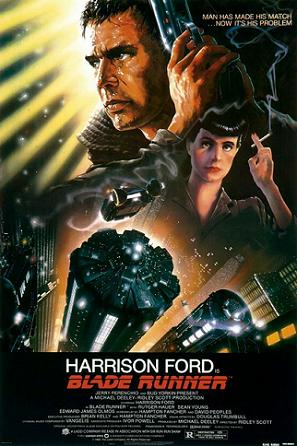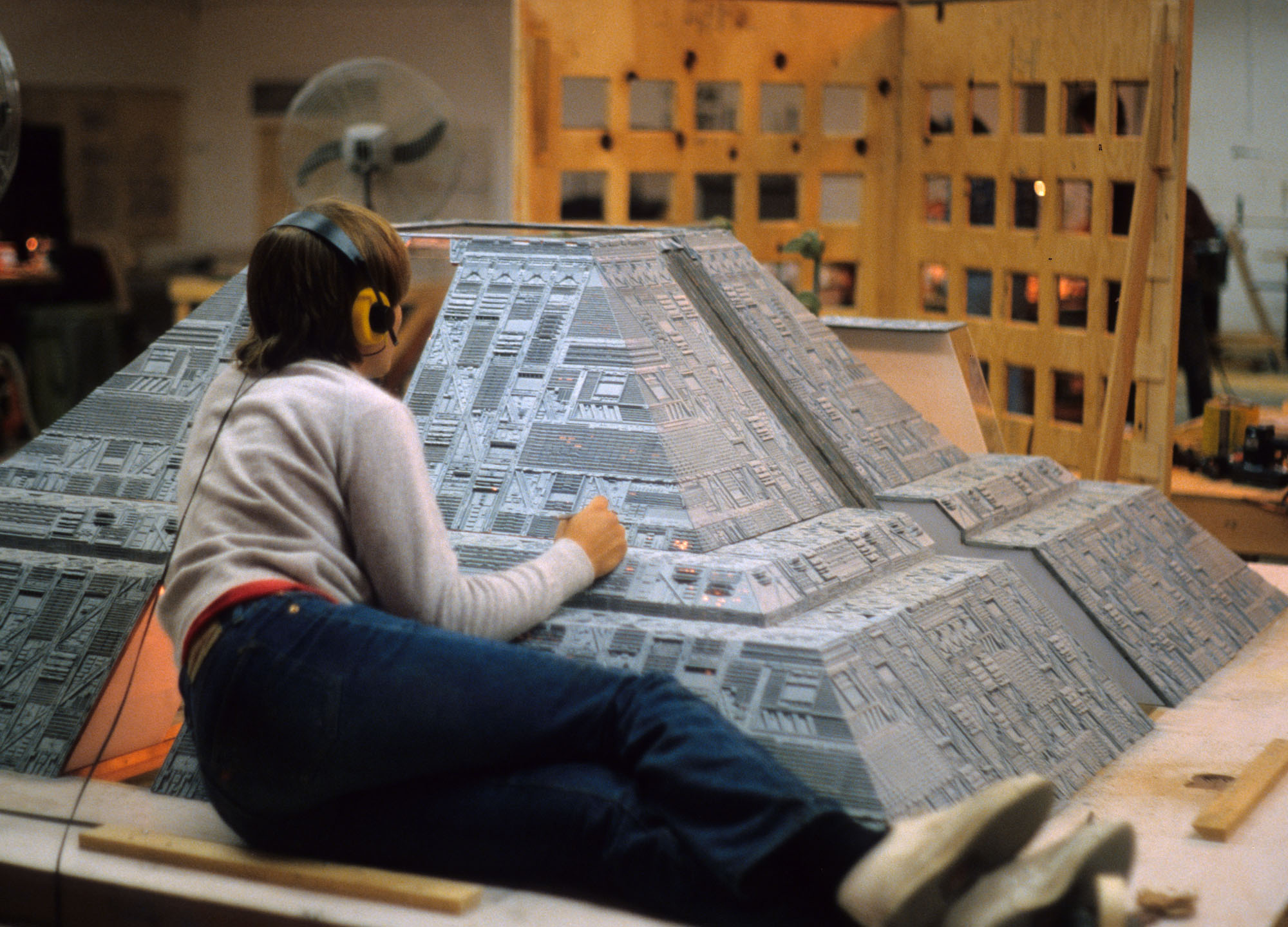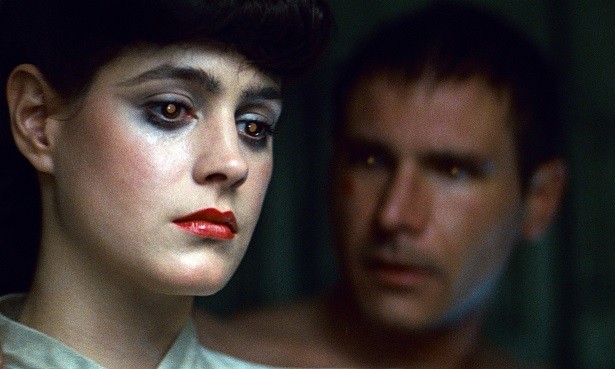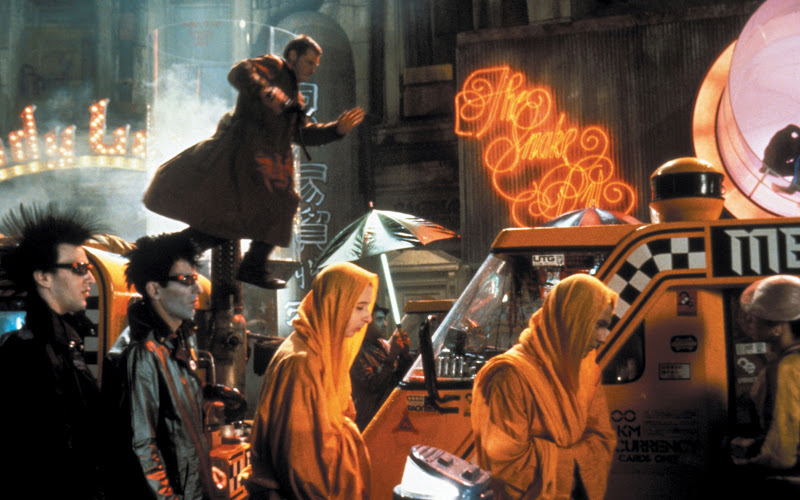 Blade Runner (1982)
Blade Runner (1982)
*** Burke Favorite ***
Dir: Ridley Scott
Stars: Harrison Ford, Rutger Hauer, Sean Young, Daryl Hannah, Joanna Cassidy and Edward James Olmos
I love those movie experiences where you feel completely different as you’re watching the movie – and completely different afterwards, too. Like you can’t get the film, its themes, characters and scenes out of your mind. I didn’t actually feel that way the first time I saw Blade Runner. But, as I age, the film becomes more and more significant to me. Perhaps it’s because of the philosophical, mind-bending question at its center. Regardless, most films that I love share common elements. A unique story, an impressive cast, “that scene” and thought provoking themes that stay with me. Ridley Scott’s 1982 classic, and particularly its 2007 definitive version, have all the pieces.
A scroll at the open of the film explains that a “blade runner” is a member of a special LAPD unit in 2029. The runners’ task is to hunt down and “retire” replicants, which are artificial human beings made by the Tyrell Corporation. Replicants are so identically human, they are really difficult to spot. Only asking them a series of questions designed to reveal their nature will truly ID them – which makes for great drama, of course. In the typical “Frankenstein” story set up, it seems that once again humanity has built something it can’t control. And former blade runner Deckard (Ford) is tasked with his most challenging assignment yet – to retire four replicants who have come home to L.A. after slaughtering a mass of miners on an outlying colony.
I mean, what a set up. If you were reading this script, you would probably lean in at this point. The replicants have their own little mission, and that is to find their maker, Dr. Eldon Tyrell, and see what he can do to expand their life expectancy – in case I neglected to mention it, replicants are designed to live only four years. But anyhow, leaning in is  exactly what I do as Deckard sits in his former superior, Bryant’s office (M. Emmett Walsh, one of my favorite character actors). Bryant introduces Deckard to Pris (Hannah), who is designed for sexual pleasure. Then Zhora (Cassidy) who is a combination of sex and violent tendencies. And then there’s Leon (Brion James, another great character actor). Leon has already killed here on earth: he was being interviewed for a job, and the interviewer asked that series of questions I mentioned. They got around to a question about Leon’s mother – to which Leon reacted by shooting the man to death.
exactly what I do as Deckard sits in his former superior, Bryant’s office (M. Emmett Walsh, one of my favorite character actors). Bryant introduces Deckard to Pris (Hannah), who is designed for sexual pleasure. Then Zhora (Cassidy) who is a combination of sex and violent tendencies. And then there’s Leon (Brion James, another great character actor). Leon has already killed here on earth: he was being interviewed for a job, and the interviewer asked that series of questions I mentioned. They got around to a question about Leon’s mother – to which Leon reacted by shooting the man to death.
Finally, we have Roy Batty, played by Rutger Hauer in one of his best roles. Batty is most appropriately named. He’s the quintessential villain, the kind who’s terrifying whether he’s in this early 80s film, a 1930s horror classic or a modern day thriller. He is frightening in his behaviors, mannerisms, speech and idiosyncrasies, even when he doesn’t intend to be. And his bloody dialogue! “Gosh, ya really got some nice toys here…” He has white hair and a stylish high collar leather jacket. He’s incredibly strong as he demonstrates several times over the course of the film. In short, he makes a great challenge for our hero, Deckard to meet. But brining it back to what I was originally saying, how Runner really creates a world of its own, pulls you into it and keeps you there for two hours – Batty does not work with all the cinematic elements that surround him.
 Ridley Scott successfully designs a Los Angeles that is overwhelmingly crowded. Distinctive, convincing blimps patrol the skies, and they bombard the crowds below with ads for Coca-Cola, Toshiba and RCA. It’s fun to watch the film and identify which brands have endured – and which have been “retired.” But the future thinking isn’t unique to the design, it’s embedded in the costumes. The music by Vangelis fits the crazy, flying cars, the insane collars, the incessant rain and the oil rigs that blow flames from their tops. Even the sound design contributes to the amazing mix with curious echoes and synthetic sounds that make us wonder, “is that real or inserted for effect?” As a result, this “bad guy” replicant, Batty, works in scaring us only because his surroundings are so successfully composed and presented. None of these items are revealed because it’s time to do so. Scott’s presentation of the story is at Runner’s center – which is one of the reasons the film works and endures.
Ridley Scott successfully designs a Los Angeles that is overwhelmingly crowded. Distinctive, convincing blimps patrol the skies, and they bombard the crowds below with ads for Coca-Cola, Toshiba and RCA. It’s fun to watch the film and identify which brands have endured – and which have been “retired.” But the future thinking isn’t unique to the design, it’s embedded in the costumes. The music by Vangelis fits the crazy, flying cars, the insane collars, the incessant rain and the oil rigs that blow flames from their tops. Even the sound design contributes to the amazing mix with curious echoes and synthetic sounds that make us wonder, “is that real or inserted for effect?” As a result, this “bad guy” replicant, Batty, works in scaring us only because his surroundings are so successfully composed and presented. None of these items are revealed because it’s time to do so. Scott’s presentation of the story is at Runner’s center – which is one of the reasons the film works and endures.
However, I’ve alluded to this deep philosophical question that accompanies this sci-fi/action classic. And that is the very question, what if you were a replicant – and no one told you. It’s like the old game of asking yourself, if you could talk to a mystic and they would tell you the date of your death… would you ask them? The question is presented in earnest in an early scene where Deckard visits Dr. Tyrell and the doc has him interview his secretary, Rachael (Young). At the end of the montage of the investigator asking this beautiful woman questions, the doc asks Rachael to excuse them and when she’s out of the room, Tyrell asks Deckard what he thinks of her. Deckard tells Tyrell he understands she’s a replicant – but it took many more questions before he realized it.
Further, poor Rachael doesn’t KNOW she’s a replicant. Tyrell has embedded her synthetic brain with memories, things that happened between her mother and her, distinctive moments from childhood and the like. Deckard reveals these to Rachael in a different scene, and we see how incredibly difficult the revelation is for her. In fact… she may not be the only character unaware of their true nature (see note 1).
I also referred to “that scene,” which is a reference I need to work on. Nonetheless, Runner has it when Deckard finds Zhora in a sleazy downtown dance joint. The scene, like many in the film, and aptly reflected in the film’s poster, too, has a look, feel and tone of some noir pic from the 40s. Anyhow, as Zhora discovers who Deckard is, she escapes, and he pursues through these incredibly busy, crowded downtown streets. Her death scene really turns the film for me – not only is it incredibly violent, but it also brings home that thought presented earlier… what if the blade runner is wrong? How many retired replicants weren’t synthetic Tyrell corp machines at all?
In closing, I don’t mean to ramble when I cover films like this that I love, that have heavily influenced my own writing and ideas for films. But, I hope you take the time to see Blade Runner because of its futuristic look and feel – and how it presents the idea, “what if a machine could learn to love?” Not to mention how close the film is in some ways to the world we’re living in now! And yet… it’s not always on – Deckard still uses a phone booth in the film. Anyhow – if you do check it out, you’ll be all ready for Blade Runner: 2049, in theaters Friday, 10/6/2017… You can expect an entry on this sequel, too.
NOTE 1: for those who haven’t seen the original film, please don’t read…
I have not watched all of BR’s Blu-Ray extras yet, but I understand that many Runner Fans insist that Deckard himself is a replicant. I will admit that the “definitive” 2007 edition certainly does a good job of presenting this “what if” scenario. The unicorn dream that Deckard has, accompanied by the Olmos character’s dialogue at the end, “..it’s too bad she won’t live too long… but then again, who does?” which Deckard considers as he sees the origami of the unicorn… this entire sequence is best presented in the final version.
 But, my question is, if Deckard IS one – he’s a bad one, right? As in, he’s an early, outdated model that’s not quite up to the task…? He’s incredibly out-matched by these four newer models – I hope that’s the thought? Because… Bryant advises in the beginning that they have been designed “to develop their own emotional levels” to fit in ever better… Well, to me, Deckard seems very human indeed. He’s out-matched by these superior, synthetic androids. He does not dramatically change in a way that presents the idea to me that he is a replicant.
But, my question is, if Deckard IS one – he’s a bad one, right? As in, he’s an early, outdated model that’s not quite up to the task…? He’s incredibly out-matched by these four newer models – I hope that’s the thought? Because… Bryant advises in the beginning that they have been designed “to develop their own emotional levels” to fit in ever better… Well, to me, Deckard seems very human indeed. He’s out-matched by these superior, synthetic androids. He does not dramatically change in a way that presents the idea to me that he is a replicant.
But then again… if you think of that sequence where Rachael saves his life from Leon killing him, and they go back to his apartment… Deckard’s EYES have that incredibly subtle orange glow to them, which Rachael’s had in the Q&A scene, which the owl in the room shared… And at that moment, she asks Deckard, “did ya ever take that test yourself?” Chills, my friends….
Enjoy the classic trailer below:
Disclaimer: I own none of the pictures or clip included – if the images need to be replaced, please contact admin.

